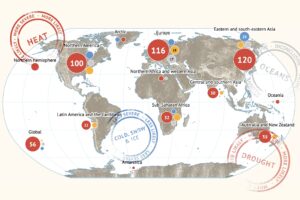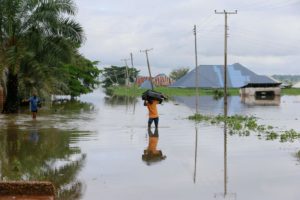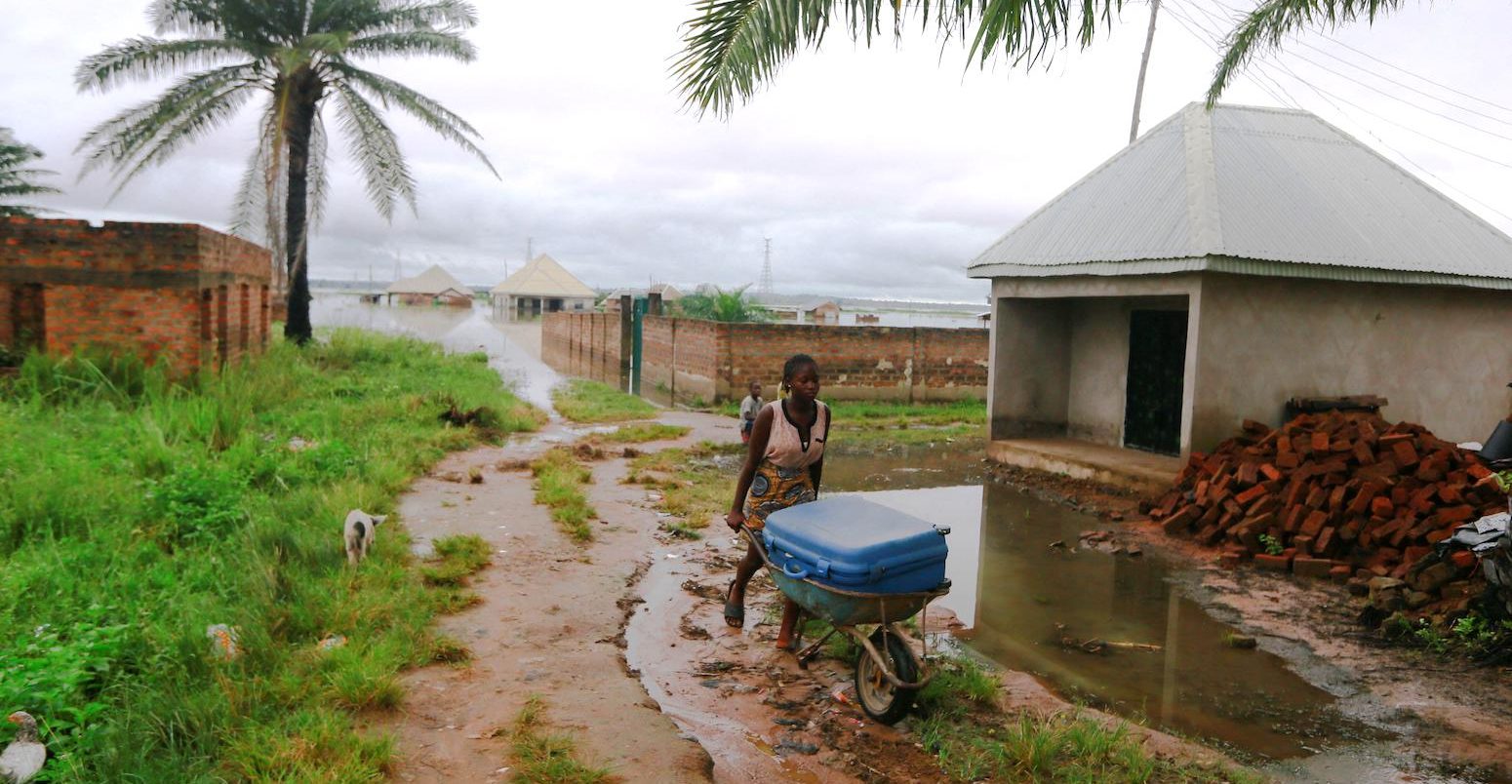
Analysis: Africa’s unreported extreme weather in 2022 and climate change
Daisy Dunne
10.26.22Daisy Dunne
26.10.2022 | 3:15pmFrom deadly floods in Nigeria to devastating drought in Somalia, Africa has faced a run of severe – and sometimes unprecedented – extreme weather events since the start of 2022.
But while the US hurricane season and 40C heat in the UK have captured headlines, many of Africa’s most extreme and life-changing weather events went largely unreported in global-north media.
Ahead of COP27 in Egypt – which is being referred to as “Africa’s COP” – Carbon Brief has used disaster data, humanitarian reports and local testimony to investigate Africa’s 2022 extreme weather events – and examined how they could be linked to climate change, according to scientists.
Carbon Brief’s analysis of disaster records finds that extreme weather events in Africa have killed at least 4,000 people and affected a further 19 million since the start of 2022. However, the impacts of African extreme events often go unrecorded – especially for heatwaves – and so the true figures are likely to be much higher.
The investigation also shows that:
- Drought and famine have killed 2,500 people in Uganda and affected eight million in Ethiopia this year.
- More than 600 people have died in Nigeria’s worst floods in a decade. This includes 76 people who were killed when a boat carrying flood victims capsized.
- Southern African countries, including Madagascar and Mozambique, were battered by six severe storms this year, killing at least 890 people.
- Temperatures reached 48C in Tunisia in July, fanning the flames of extreme wildfires.
- Nearly two million people in Chad were affected by floods in August and October.
The toll of extreme weather on African lives is one example of “loss and damage” – a term to describe how climate change is already harming people, especially the world’s most vulnerable.
Loss and damage is expected to feature heavily at COP27, where global-south nations will call on developed countries to provide funds for the climate impacts they are already experiencing. (See Carbon Brief’s recent special series on loss and damage for more details.)
“Africa contributes 4% of global emissions, yet is at the frontline of the loss and damage. Loss and damage finance is not negotiable,” Adenike Oladosu, a climate activist from Nigeria, tells Carbon Brief.
Continent of extremes
Africa is one of the most vulnerable continents in the world to climate change, according to the Intergovernmental Panel on Climate Change (IPCC).
In 2022, every part of the continent was affected by extreme weather events, ranging from wildfires in Algeria to catastrophic flooding in South Africa.
To study these events, Carbon Brief has combined UN humanitarian reports and local news stories with data from the Emergency Events Database (EM-DAT), which was launched in 1988 by the Centre for Research on the Epidemiology of Disasters (CRED) in Belgium.
The map below shows extreme weather events affecting Africa in 2022 to date, according to the EM-DAT database. On the map, the size of the circles correspond to the number of people affected by the event, while a colour key indicates the event type.
For an extreme event to be featured on the EM-DAT database, it must fulfil one of the following criteria:
- 10 or more people dead.
- 100 or more people affected.
- The declaration of a state of emergency.
- A call for international assistance.
(It is worth noting that the EM-DAT is the largest disaster database available, but is still not exhaustive, particularly for African nations. In addition, some of the most recent extreme events to strike Africa, such as Nigeria’s October floods, have not yet been added.)
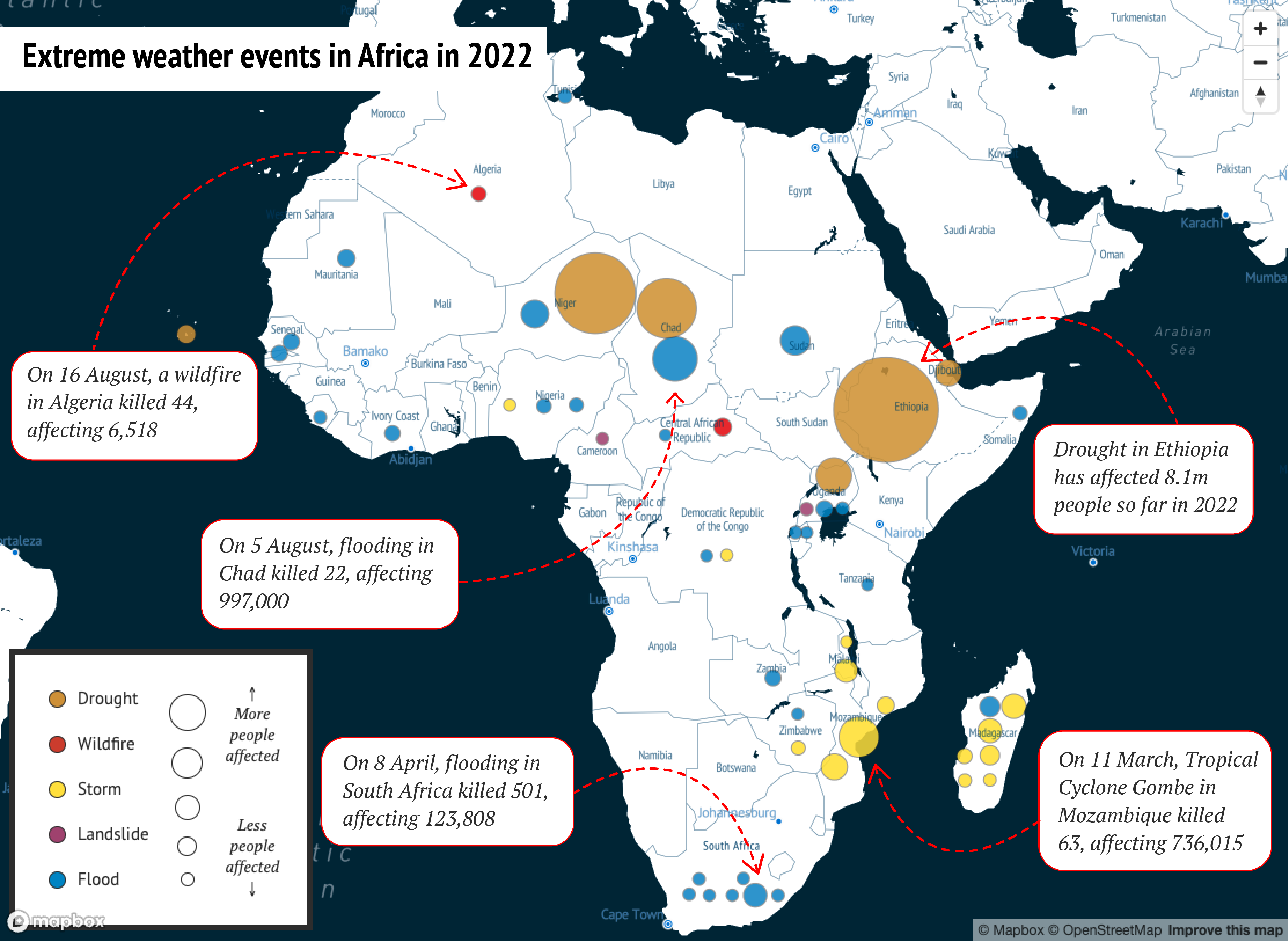
Carbon Brief analysis of the EM-DAT database finds that extreme weather events in Africa have killed at least 4,000 people and affected a further 19 million since the start of 2022.
However, the impacts of African extreme events often go unrecorded – especially for heatwaves (see below) – and so the true figures are likely to be higher.
Overall, 2022 has shown how climate change is already having major consequences for vulnerable populations across Africa, says Dr Friederike Otto, a prominent extreme weather scientist at Imperial College London. She tells Carbon Brief:
“The biggest impact of climate change is not so much that single events have been made more extreme, but that there are even more extreme weather events in a region that already has always suffered from very high natural variability and high vulnerability. Just small changes in the number of extreme events are already having a huge impact.”
Cyclones
Southern African countries faced a series of severe cyclones in the first few months of 2022, killing at least 890 people and affecting a further 2.8 million, according to a report from the UN Office for the Coordination of Humanitarian Affairs (OCHA).
This included:
- Tropical Storm Ana, which caused 171 deaths across Madagascar, Mozambique, Malawi and Zimbabwe in January.
- Tropical Cyclones Batsirai and Emnati, which killed 136 people in Madagascar in February.
- Tropical Storm Dumako, which killed 14 people in Madagascar and Mozambique in February.
- Tropical Cyclone Gombe, which killed 103 people in Mozambique and Malawi in March.
- Tropical Storm Jasmine, which affected 5,000 people in Madagascar in April.
Heavy rain and floods associated with the storms contributed to outbreaks of water-borne diseases, food insecurity and malnutrition, according to the OCHA report.
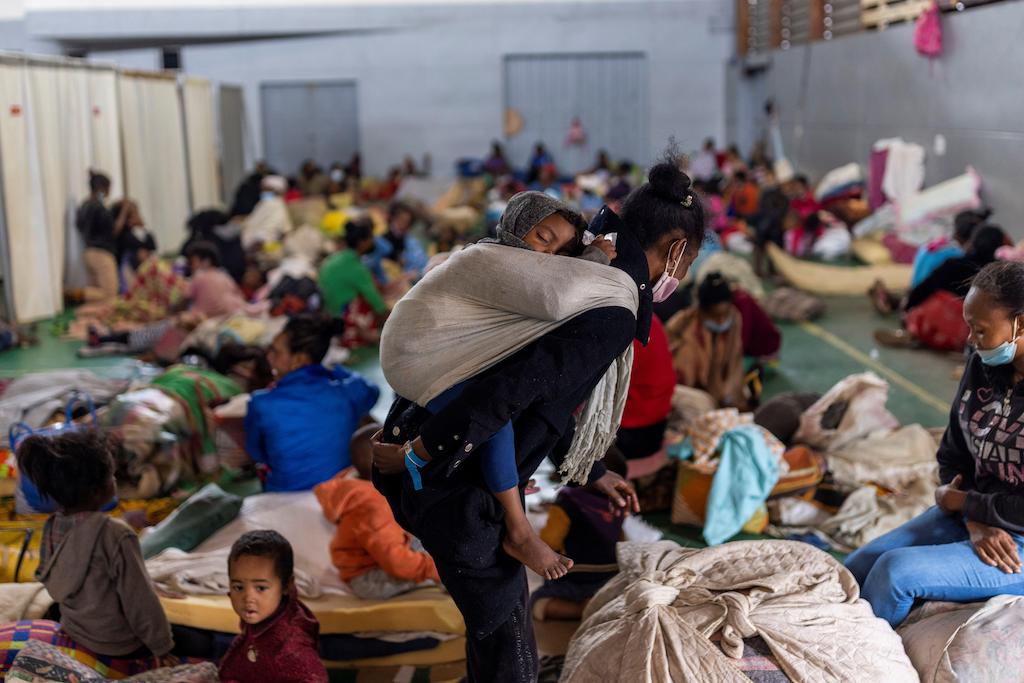
Cholera outbreaks were recorded in Malawi, Mozambique, Tanzania and Zambia, the report says, while an increase in malaria was reported in Mozambique and Madagascar.
In the Grand Sud-Est of Madagascar, food insecurity reached crisis levels, while in Malawi, “many families lost their food stocks when their homes were destroyed or flooded by the tropical storms”, according to the report.
The map below, taken from the OCHA report, shows the path of cyclones in southern Africa (red) and the impacts of their associated heavy rains and flooding (blue) during the first six months of 2022. The map also illustrates the number of people affected (grey bubbles) and the location of disease outbreaks.
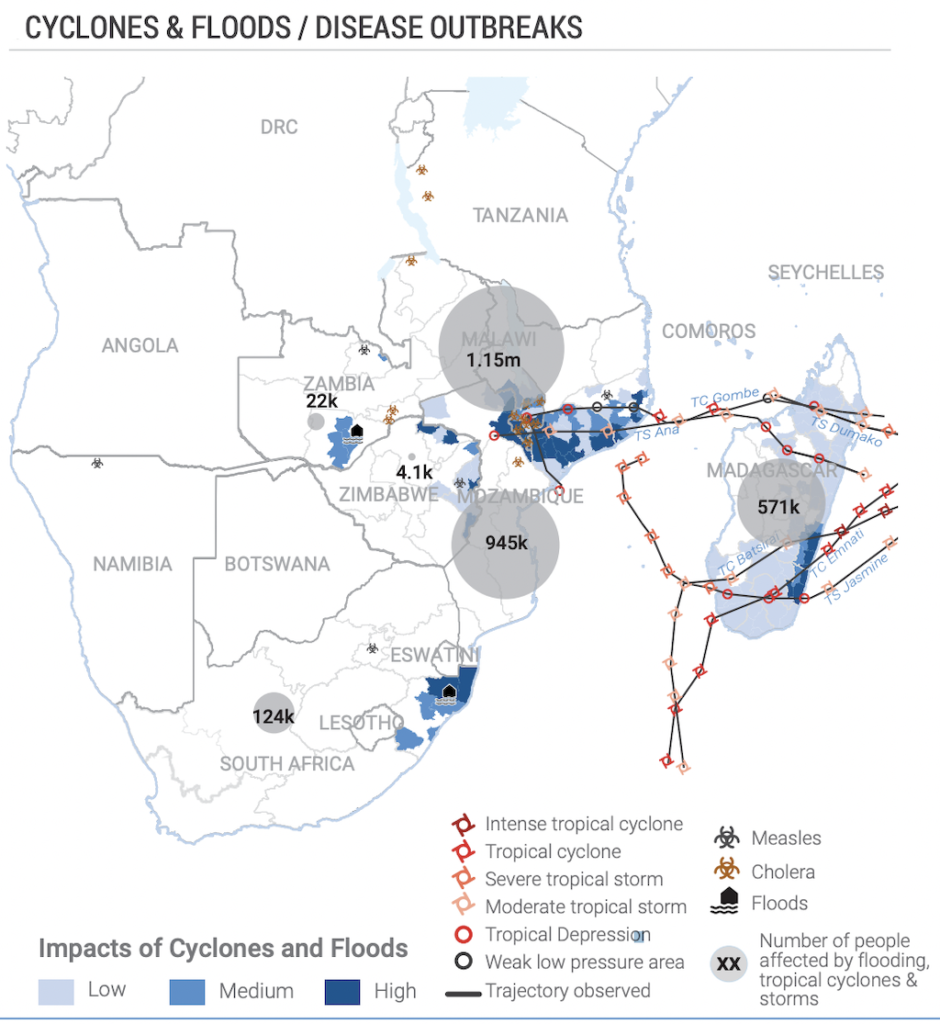
Storms affecting this part of southern Africa originate in the south-west Indian Ocean, a known hotspot for cyclones, explains Dr Izidine Pinto, a climate scientist from Mozambique currently working at the Red Cross Red Crescent Climate Centre in South Africa. He tells Carbon Brief:
“Tropical cyclones and flooding is something that is frequent in Mozambique, happening maybe once or two times a year usually.”
The 2021-22 south-west Indian Ocean cyclone season was “above average”, producing 12 named storms and five tropical cyclones, according to analysis from the US state Joint Typhoon Warning Center.
Pinto was part of a group of scientists who earlier this year produced a rapid analysis examining the influence of human-caused climate change on storms Ana and Batsirai.
The study found that climate change led to an increase in the intensity of the rainfall associated with the two storms. Otto, who led the analysis, explains to Carbon Brief:
“We found that climate change made the rainfall associated with these tropical cyclones more likely, but there’s still a lot of open questions.
“What about the wind speeds? We looked at two cyclones, but there were actually several tropical cyclones hitting that area this year. And so a really important and still open question is, is this compounding of events becoming more likely because of climate change?”
(The analysis is an example of “attribution science”, a fast growing field examining the fingerprint of climate change on extreme events. More than 400 attribution studies have now been published, which Carbon Brief has mapped.)
Overall, the findings of the analysis are in line with the conclusions of the most recent IPCC assessment of the extent of human-caused climate change, says Pinto, who was a lead author of the report:
“We found that extreme rainfall events are becoming more intense in many parts of the world, including Mozambique. We see that, when a cyclone happens, the amount of rainfall is larger compared to previous tropical cyclones.”
In its most recent assessment of climate change’s impact on Africa, the IPCC concludes that eastern southern Africa is likely to see an increase in average tropical cyclone wind speeds and rainfall, as well as a higher proportion of category 4 and 5 (the most severe) storms, as climate change worsens.
Floods
From east to west and north to south, much of the African continent has faced severe flooding in 2022.
Carbon Brief analysis of EM-DAT data shows there have been at least 29 flood disasters reported in countries, including Chad, the Democratic Republic of the Congo, Gambia, Ghana, the Ivory Coast, Mauritiana, Madagascar, Nigeria, Rwanda, Sudan, Somalia, Senegal, South Africa, Tunisia, Uganda, Zambia and Zimbabwe.
Some of the most extreme flooding has taken place in west Africa.
This includes an ongoing flood in Nigeria, which has so far killed more than 600 people and affected a further 1.3 million, according to government briefings to the media. The floods are the most severe the country has seen in a decade.
Among the dead are 76 people who were killed when a boat carrying flood victims capsized.
At least 76 people in Nigeria were killed after a boat carrying flood victims capsized.
— AJ+ (@ajplus) October 10, 2022
Many were families fleeing floods in Anambra that have destroyed communities. Nigeria is facing its worst floods in a decade, devastating crops and making at least 100,000 people homeless. pic.twitter.com/MbjwtiEMkS
The flooding is having a vast range of impacts across Nigeria, climate activist Adenike Oladosu tells Carbon Brief:
“Lives are lost, classrooms submerged with water, thereby affecting education; farmers left with nothing other than an empty flood-filled landscape while economic activities are disrupted.
“This flood has cost more than Hurricane Ian [which hit parts of the US and Caribbean in September], yet the media from the global north have not given it the attention it deserves. It shows the disparity in media reporting.”
Other serious events include two floods in Chad, the first affecting 977,000 people in August and the second affecting one million people in October, according to EM-DAT data and newswire reporting.
The flood came amid the country’s heaviest rainfall in 30 years, according to a UN OCHA report. The report continues:
“Through August, torrential rainfall and floods have left parts of the capital N’Djamena submerged under water and forced thousands to flee their inundated houses.
“Floods are frequent in west and central Africa during the rainy season, which typically lasts from May to October. However, this year the rains came in greater quantity, immediately flooding ponds and drainage systems. Large parts of the region are now underwater, with numerous countries recording above-average precipitation.”
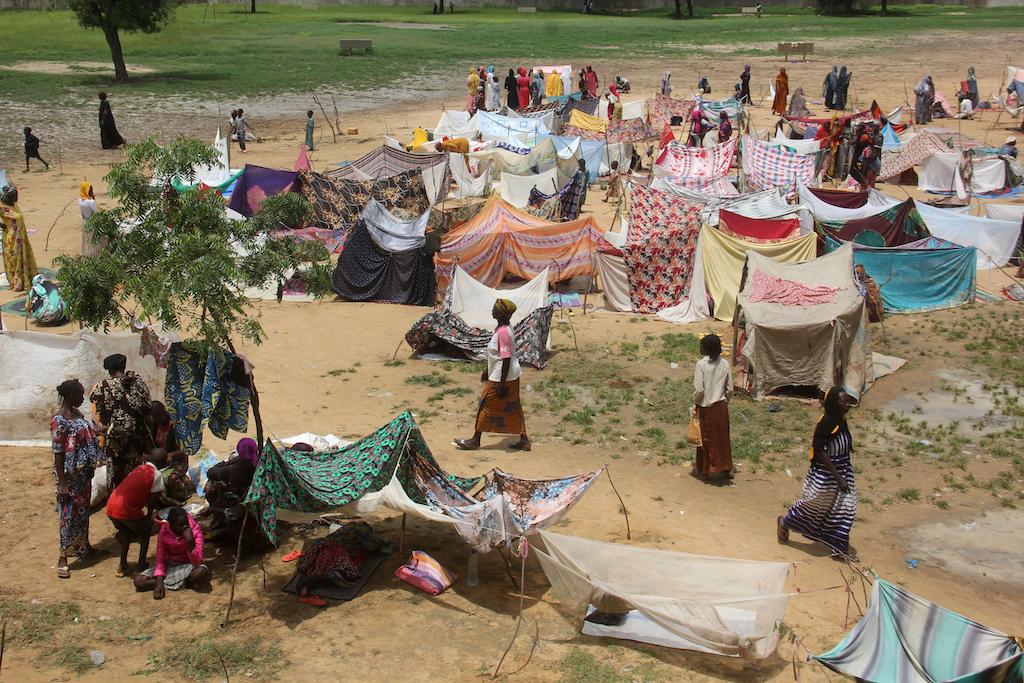
Otto’s team of extreme weather scientists are currently working to assess the role of climate change in flooding in Nigeria and neighbouring countries, she tells Carbon Brief:
“There are lots of floods in different parts of western Africa this year and the big question that we are getting closer to having an answer to is: are they all the same event?”
During west Africa’s rainy season, high levels of precipitation are delivered by the Intertropical Convergence Zone (ITCZ), a belt of stormy weather that encircles the planet near the equator and brings seasonal rainfall to tropical regions, Otto explains:
“[The ITCZ] has stayed north a bit longer this year than it would normally do, and that is clearly visible in the rainfall; there is above-average rainfall in northern parts of western Africa. We will be hopefully looking into whether there is a climate change signal in that.”
Patterns of precipitation can explain a lot about the global climate system. The Intertropical Convergence Zone (ITCZ) is the striking feature close to the equator. Notice it has a seasonality (shifting north or south).
— Zack Labe (@ZLabe) October 23, 2019
Visualization by @NASAHyperwall: https://t.co/NYl5xQVZBW pic.twitter.com/6wg9gz4OA3
Flooding across west African nations this year not only highlights the impact of climate change, but also that of poor planning, adds Dr Frederick Dapilah, a climate researcher from the Simon Diedong University of Business and Integrated Development Studies in Ghana, which also faced severe flooding in October. He tells Carbon Brief:
“The floods experienced in west Africa resulted from extreme rainfall events leading to the overflow of rivers and the spillage of artificial dams. The spillage of the Weija Dam on 3 October 2022 led to the submergence of several communities in Accra. Likewise, the spillage of the Bagre Dam in Burkina Faso on 4 September 2022, affected about 28 districts and several communities living along the Black and White Volta rivers in northern Ghana.
“The take-home message is that, in light of increasing climate change, current adaptation and mitigation interventions in west Africa are failing and are not providing desired outcomes. Hence, transformative adaptation and mitigation measures are urgently needed to protect human lives and property now and in the future.”
Southern Africa also faced serious flooding in 2022. In April, 459 people were killed and a further 40,000 affected in floods and landslides in the South African provinces of KwaZulu-Natal and Eastern Cape.
The flood – described as “the biggest tragedy we have ever seen” by South Africa’s president Cyril Ramaphosa – was driven by two days of extreme rainfall, according to a snap analysis led by Pinto.
The analysis found that this extreme rainfall was made twice as likely by human-caused climate change. Pinto explains:
“The main finding was that climate change contributed to the increase of the heavy precipitation that happened in KwaZulu Natal, South Africa. These kinds of events can happen naturally but, because of climate change, they are becoming more intense.”
The impact of South Africa’s flood was particularly high because it hit “vulnerable populations”, adds Otto:
“In the KwaZulu Natal area, lots of people in informal housing died in the event because there was just no protection.”
According to the IPCC’s most recent assessment of Africa, human-caused climate change has already contributed to an increase in heavy rainfall and flooding across nearly all parts of the continent.
With continued climate change, flooding is projected to worsen in every African region, according to the assessment.
Heatwaves
Human-caused climate change has led to an increase in the intensity and frequency of heatwaves in every region of the world, according to the IPCC.
However, the impact of heatwaves on people is not routinely recorded in Africa. According to the EM-DAT database (see map above), there were no recorded heatwave disasters anywhere in Africa this year. (In fact, EM-DAT lists no more than two heatwaves in sub-Saharan Africa since the beginning of the 20th century.)
This is despite the fact that many parts of the continent did battle extreme heat in 2022.
For example, in July, temperatures reached a record-breaking 48C in Tunis, the capital of Tunisia. This heat helped fan the flames of devastating wildfires (see below).
In March, Kenya experienced “unusually hot temperatures both during the day and night”, with temperatures of 40C recorded in the north-western town Lodwar, according to a local television report.
Kenyan meteorologists told the station that the extreme temperatures were driven by the spring “equinox”, a time when the sun crosses the equator, moving north, and so is directly above Kenya . However, they added that the heat appeared even more severe “than usual” because of climate change.
More recently, the southern-hemisphere spring months have also seen extreme heat return to many parts of southern Africa, including South Africa, Botswana and Zimbabwe, according to local news reports. (Otto tells Carbon Brief her team is also considering assessing the influence of climate change on South Africa’s current heat.)
Though episodes of extreme heat are happening, their impacts on people are not being recorded – which explains why heatwaves are missing from the EM-DAT database, Pinto says:
“Some people call heatwaves the ‘silent killer’ because we can’t see the impacts. It is easy to see flooding and people drowning and to record their deaths. But when it’s a heatwave and we don’t see the impact with our eyes, it’s difficult to record.
“So, if a heatwave happens in, say, October and kills 10 people. We don’t know what caused the death of those people. Probably, it was the increase in temperature, which caused them to go to the hospital and suffer heart failures or strokes, but the people responsible for recording the deaths do not make the association with high temperatures.”
In addition to impacts going unrecorded, African countries are also much less likely to issue heat warnings or alerts – potentially putting more lives at risk, says Otto:
“We are currently working on a project to try and identify what are meaningful heatwave thresholds so that [African countries] can put out heat warnings for populations because at the moment that just doesn’t exist. There is no awareness of heatwaves.”
According to the IPCC, there is high confidence that temperatures across Africa have risen at a faster rate than the global average since the pre-industrial era – and that the number of heatwaves across the continent has also increased.
In 2018, Carbon Brief covered research finding heatwaves in Africa could increase fivefold in a 3C hotter world.
Wildfires
Several parts of northern and central Africa saw damaging wildfires in 2022.
In February, severe forest fires were recorded in the Central African Republic amid high temperatures and drought. According to a UN OCHA report, the fires forced 500 families to seek emergency shelter, leading to outbreaks of malaria, cholera and polio.
In July, Tunisia battled intense fires amid temperatures exceeding 40C. According to the New Arab, fires broke out south of the capital city Tunis, forcing several neighbourhoods to evacuate. The fires also “badly damaged” Tunisia’s grain crop, according to Reuters.
In August, neighbouring Algeria also experienced severe wildfires amid extreme heat. According to a UN OCHA report, more than 100 fires were reported in north-eastern Algeria, killing 44 people and causing a further 2,000 to evacuate. The report continues:
“The fires also affected the livelihoods of over 6,000 people, including farmers who have lost dozens of hectares, nearly a thousand fruit trees and more than 400 heads of livestock. According to the figures from the wilayas [states], more than 6,000 hectares were destroyed by the fires. The wilaya of Souk Ahras has lost one-third of its forests.”
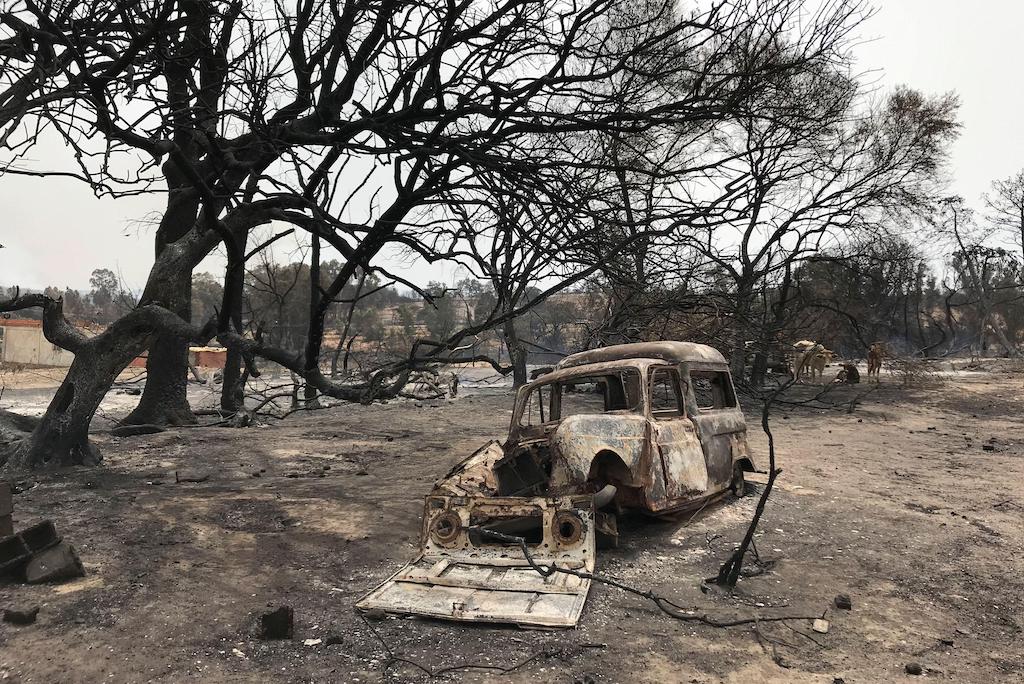
Though the factors behind every fire are complex, a body of research shows that climate change is making “fire weather” – hot, dry conditions – more likely to occur globally.
In its most recent assessment of Africa, the IPCC projects an increase in fire weather in northern, west southern and east southern regions of the continent.
Drought and famine
Severe drought continued to affect the lives of millions of people across Africa this year, particularly in eastern countries such as Ethiopia, Somalia, Rwanda, Uganda and Kenya, as well as in Chad and Niger.
Carbon Brief analysis of EM-DAT data shows that drought has affected eight million people in Ethiopia alone in 2022 – and caused 2,500 deaths in Uganda.
According to a UN OCHA report, the current situation in east Africa is “unprecedented”.
Five consecutive rainy seasons have failed – something not seen for at least 40 years, according to the UN World Meteorological Organization.
The 2022 March-May rain season was the driest on record, “devastating livelihoods and driving sharp increases in food, water and nutrition insecurity”, according to the UN OCHA report. It continues:
“An estimated 3.6m livestock have died in Kenya and Ethiopia. In the worst-affected areas of Somalia, one-out-of-three livestock have perished since mid-2021. Over a million people have been displaced in Somalia and southern Ethiopia.”
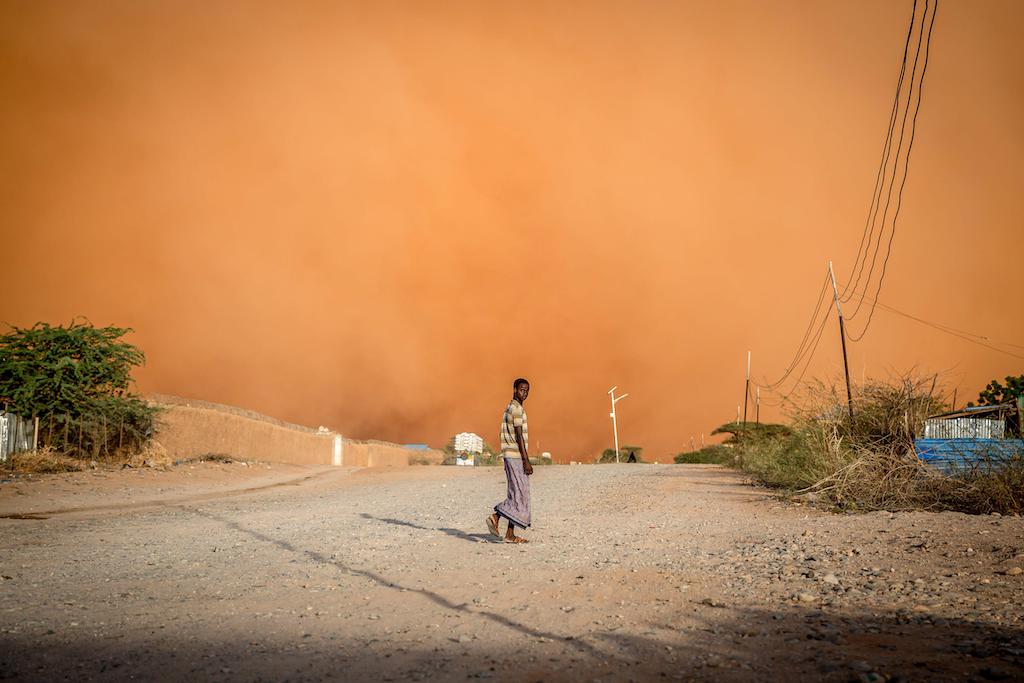
It estimates that 20 million people in the region faced high acute food insecurity by September – around twice the population of Belgium.
“Ethiopia, Somalia and Kenya have also recorded a significantly higher number of severely malnourished children admitted for treatment in the first quarter of 2022 compared to past years,” the report says.
There has not been a study examining the role of climate change in east Africa’s current drought. However, previous research into Madagascar’s 2021 food crisis found that climate change played a minor role in comparison to other factors such as poverty and poor infrastructure. Otto tells Carbon Brief:
“I think in eastern Africa the story is very similar. We haven’t really looked at west Africa, so that’s something we just don’t know. In southern Africa, it is different and there is definitely a climate change signal in the droughts.”
According to the IPCC’s most recent assessment of the continent, there has been an observed decrease in mean precipitation in northeastern Africa. However, there has not been a recorded increase in droughts.
In central and west Africa, there has been an observed increase in agricultural and ecological droughts, according to the IPCC. In southern Africa, there has been a recorded increase in droughts and dryness – and this is projected to worsen with further global warming.



